Page 343 of 2267
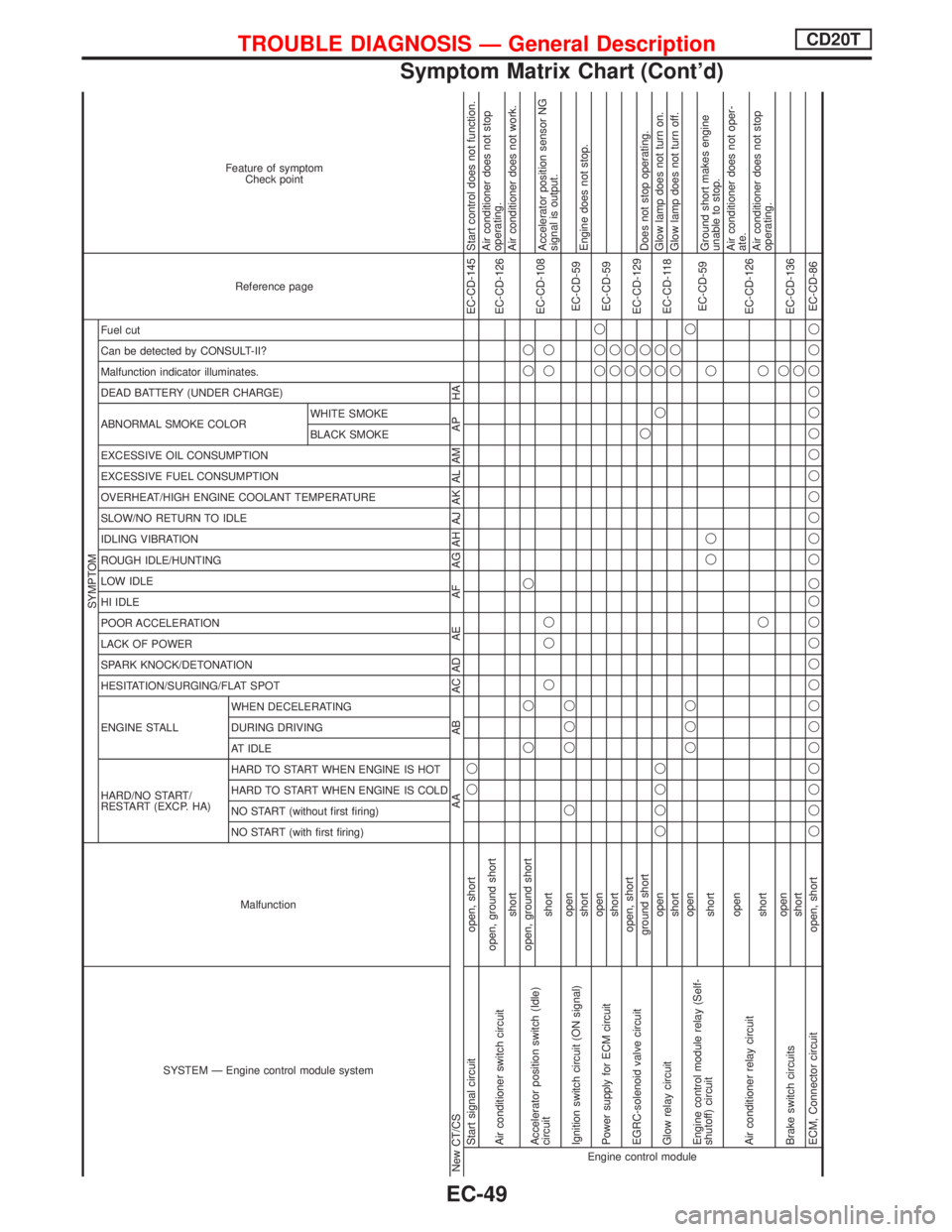
SYSTEM Ð Engine control module systemMalfunction
SYMPTOM
Reference page Feature of symptom
Check point
HARD/NO START/
RESTART (EXCP. HA) ENGINE STALL HESITATION/SURGING/FLAT SPOT SPARK KNOCK/DETONATION
LACK OF POWER
POOR ACCELERATION
HI IDLE
LOW IDLE
ROUGH IDLE/HUNTING
IDLING VIBRATION
SLOW/NO RETURN TO IDLE
OVERHEAT/HIGH ENGINE COOLANT TEMPERATURE
EXCESSIVE FUEL CONSUMPTION
EXCESSIVE OIL CONSUMPTION ABNORMAL SMOKE COLOR
DEAD BATTERY (UNDER CHARGE) Malfunction indicator illuminates.
Can be detected by CONSULT-II?
Fuel cut
NO START (with first firing) NO START (without first firing)
HARD TO START WHEN ENGINE IS COLD
HARD TO START WHEN ENGINE IS HOT
AT IDLE
DURING DRIVING
WHEN DECELERATINGBLACK SMOKE WHITE SMOKE
New CT/CS AA AB AC AD AE AF AG AH AJ AK AL AM AP HAEngine control moduleStart signal circuit open, shortqqEC-CD-145 Start control does not function.
Air conditioner switch circuitopen, ground short
EC-CD-126Air conditioner does not stop
operating.
shortAir conditioner does not work.
Accelerator position switch (Idle)
circuitopen, ground shortqq q qq
EC-CD-108
shortqqq qqAccelerator position sensor NG
signal is output.
Ignition switch circuit (ON signal)openq qqq
EC-CD-59
shortEngine does not stop.
Power supply for ECM circuitopenqqq
EC-CD-59
shortqq
EGRC-solenoid valve circuitopen, shortqq
EC-CD-129
ground shortqqqDoes not stop operating.
Glow relay circuitopenqqqq q qq
EC-CD-118Glow lamp does not turn on.
shortqqGlow lamp does not turn off.
Engine control module relay (Self-
shutoff) circuitopenqqqq
EC-CD-59
shortqq qGround short makes engine
unable to stop.
Air conditioner relay circuitopen
EC-CD-126Air conditioner does not oper-
ate.
shortqqAir conditioner does not stop
operating.
Brake switch circuitsopenq
EC-CD-136
shortq
ECM, Connector circuit open, shortqqqqqqqqqqqqq qqqqqqqqqqqqEC-CD-86
TROUBLE DIAGNOSIS Ð General DescriptionCD20T
Symptom Matrix Chart (Cont'd)
EC-49
Page 350 of 2267
TER-
MINAL
NO.WIRE
COLORITEM CONDITIOND ATA
(DC Voltage and
Pulse Signal)
344 WCrankshaft position sen-
sor (TDC) (Signal)Engine is running.
(Warm-up condition)
Idle speedApproximately 0V
NEF867
Engine is running.
Engine speed is 2,000 rpmApproximately 0V
NEF868
345 W Needle lift sensorEngine is running.
(Warm-up condition)
Idle speedApproximately 3.8 - 4.0V
NEF869
Engine is running.(Warm-up condition)
Engine speed is 2,000 rpmApproximately 3.8 - 4.0V
NEF870
347 L/BEngine coolant tempera-
ture sensorEngine is running.
0.6 - 4.8V
Output voltage varies
with engine coolant tem-
perature.
348
411R/Y Fuel temperature sensor
Engine is running.
0.6 - 4.8V
Output voltage varies
with fuel temperature.
349 SB Fuel cut solenoid valveIgnition switch ªLOCKº
Approximately 0V
Ignition switch ªONº
BATTERY VOLTAGE
(11 - 14V)
TROUBLE DIAGNOSIS Ð General DescriptionCD20T
ECM Terminals and Reference Value (Cont'd)
EC-56
Page 360 of 2267
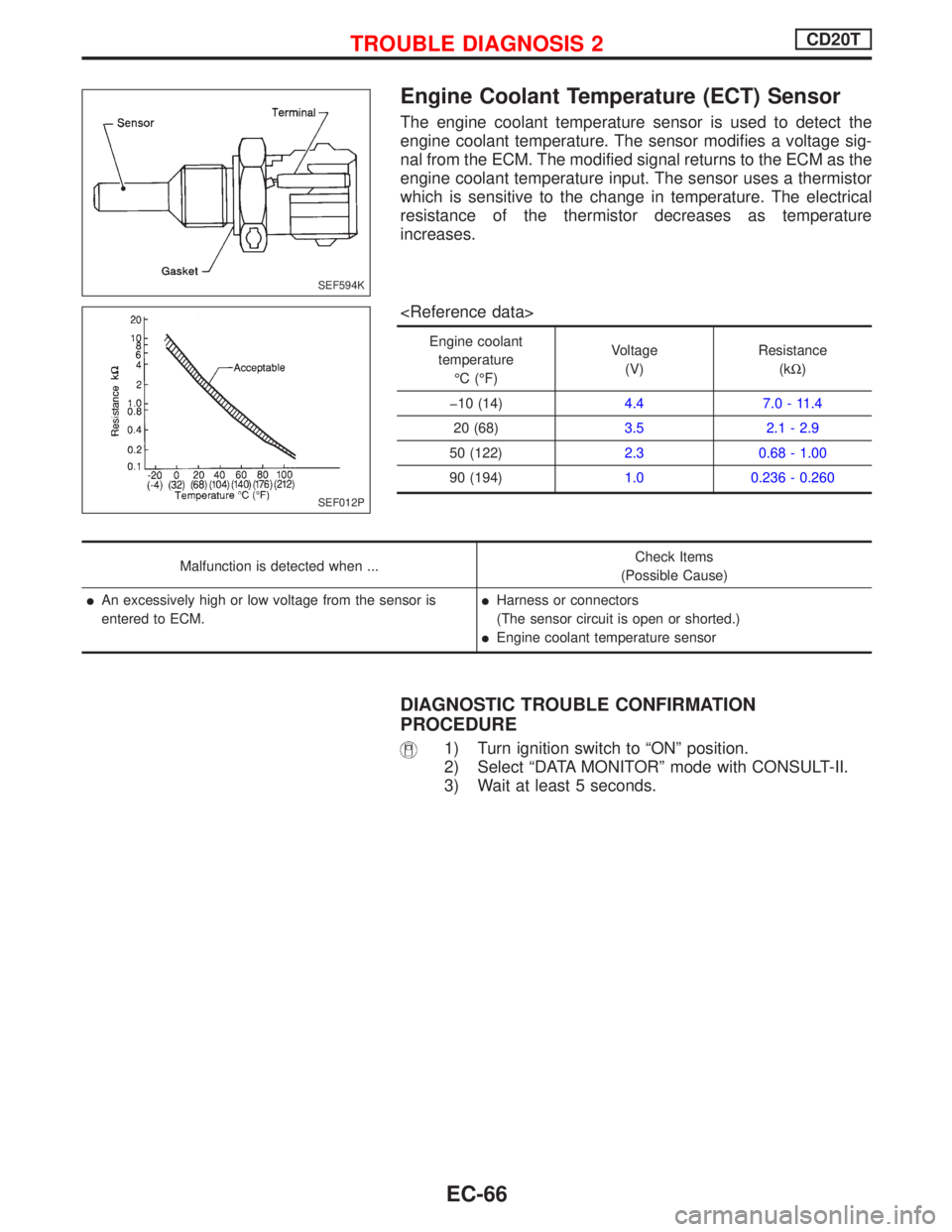
Engine Coolant Temperature (ECT) Sensor
The engine coolant temperature sensor is used to detect the
engine coolant temperature. The sensor modifies a voltage sig-
nal from the ECM. The modified signal returns to the ECM as the
engine coolant temperature input. The sensor uses a thermistor
which is sensitive to the change in temperature. The electrical
resistance of the thermistor decreases as temperature
increases.
Engine coolant
temperature
ÉC (ÉF)Voltage
(V)Resistance
(kW)
þ10 (14)4.4 7.0 - 11.4
20 (68)3.5 2.1 - 2.9
50 (122)2.3 0.68 - 1.00
90 (194)1.0 0.236 - 0.260
Malfunction is detected when ...Check Items
(Possible Cause)
lAn excessively high or low voltage from the sensor is
entered to ECM.lHarness or connectors
(The sensor circuit is open or shorted.)
lEngine coolant temperature sensor
DIAGNOSTIC TROUBLE CONFIRMATION
PROCEDURE
1) Turn ignition switch to ªONº position.
2) Select ªDATA MONITORº mode with CONSULT-II.
3) Wait at least 5 seconds.
SEF594K
SEF012P
TROUBLE DIAGNOSIS 2CD20T
EC-66
Page 361 of 2267
YEC800
ENGINE COOLANT
TEMPERATURE
SENSOR
: Detectable line for DTC
: Non-detectable line for DTC
ECM
TROUBLE DIAGNOSIS 2CD20T
Engine Coolant Temperature (ECT) Sensor
(Cont'd)
EC-67
Page 362 of 2267
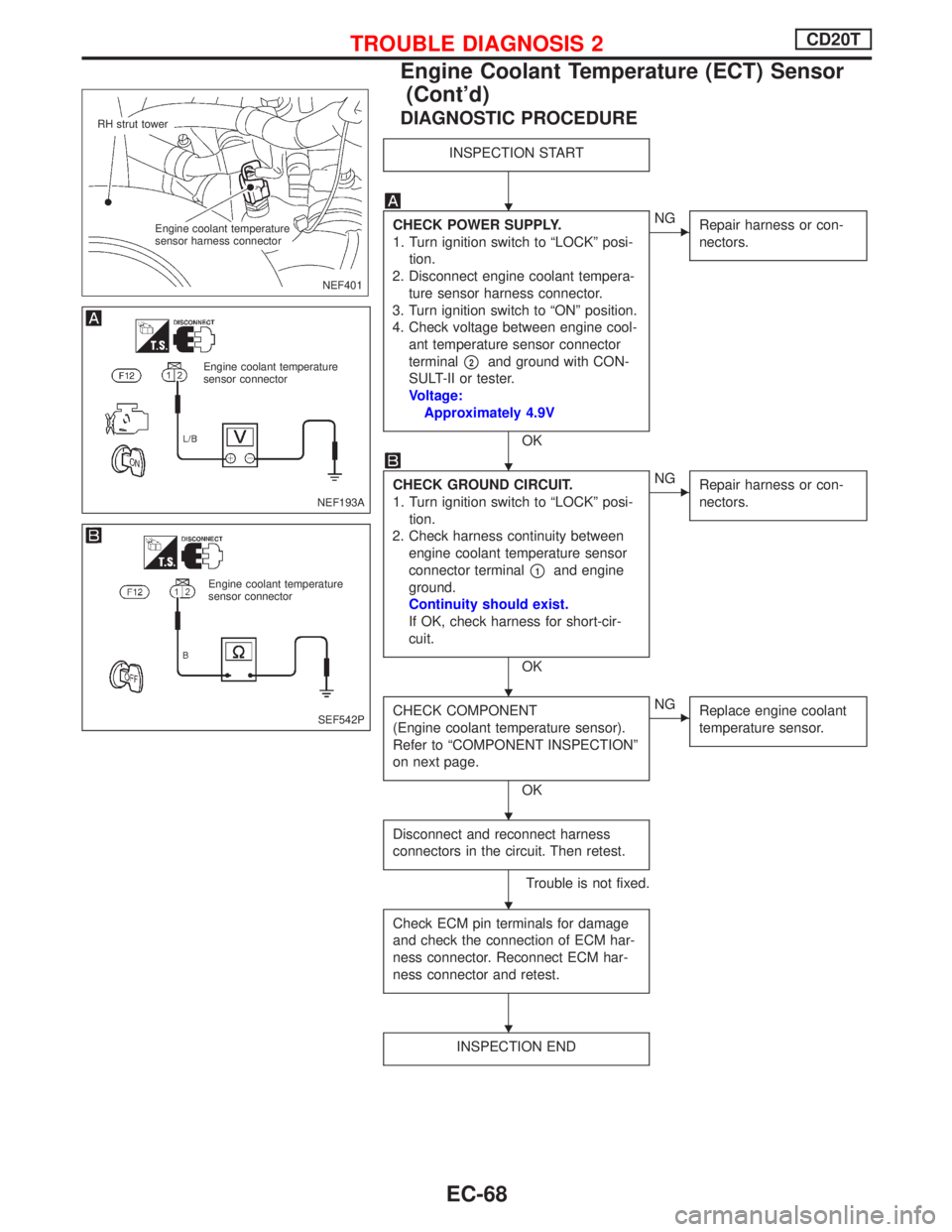
DIAGNOSTIC PROCEDURE
INSPECTION START
CHECK POWER SUPPLY.
1. Turn ignition switch to ªLOCKº posi-
tion.
2. Disconnect engine coolant tempera-
ture sensor harness connector.
3. Turn ignition switch to ªONº position.
4. Check voltage between engine cool-
ant temperature sensor connector
terminal
p2and ground with CON-
SULT-II or tester.
Voltage:
Approximately 4.9V
OK
ENG
Repair harness or con-
nectors.
CHECK GROUND CIRCUIT.
1. Turn ignition switch to ªLOCKº posi-
tion.
2. Check harness continuity between
engine coolant temperature sensor
connector terminal
p1and engine
ground.
Continuity should exist.
If OK, check harness for short-cir-
cuit.
OK
ENG
Repair harness or con-
nectors.
CHECK COMPONENT
(Engine coolant temperature sensor).
Refer to ªCOMPONENT INSPECTIONº
on next page.
OK
ENG
Replace engine coolant
temperature sensor.
Disconnect and reconnect harness
connectors in the circuit. Then retest.
Trouble is not fixed.
Check ECM pin terminals for damage
and check the connection of ECM har-
ness connector. Reconnect ECM har-
ness connector and retest.
INSPECTION END
NEF401
.RH strut tower
.Engine coolant temperature
sensor harness connector
NEF193A
Engine coolant temperature
sensor connector
SEF542P
Engine coolant temperature
sensor connector
H
H
H
H
H
H
TROUBLE DIAGNOSIS 2CD20T
Engine Coolant Temperature (ECT) Sensor
(Cont'd)
EC-68
Page 363 of 2267
COMPONENT INSPECTION
Engine coolant temperature sensor
Check resistance as shown in the figure.
Temperature ÉC (ÉF) Resistance kW
20 (68)2.1 - 2.9
50 (122)0.68 - 1.0
90 (194)0.236 - 0.260
If NG, replace engine coolant temperature sensor.
SEF152P
SEF012P
TROUBLE DIAGNOSIS 2CD20T
Engine Coolant Temperature (ECT) Sensor
(Cont'd)
EC-69
Page 381 of 2267
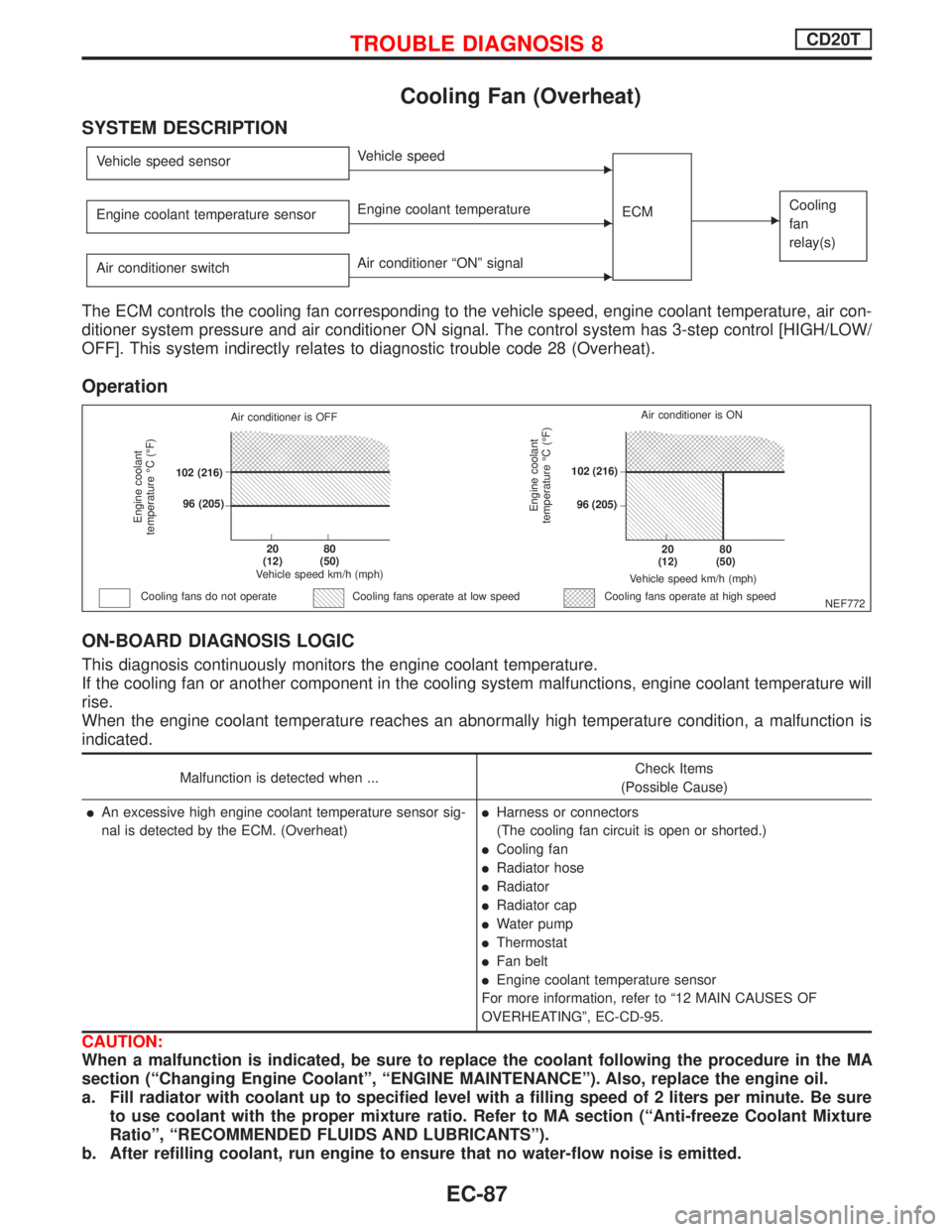
Cooling Fan (Overheat)
SYSTEM DESCRIPTION
Vehicle speed sensorEVehicle speed
ECM
ECooling
fan
relay(s)Engine coolant temperature sensorEEngine coolant temperature
Air conditioner switch
EAir conditioner ªONº signal
The ECM controls the cooling fan corresponding to the vehicle speed, engine coolant temperature, air con-
ditioner system pressure and air conditioner ON signal. The control system has 3-step control [HIGH/LOW/
OFF]. This system indirectly relates to diagnostic trouble code 28 (Overheat).
Operation
ON-BOARD DIAGNOSIS LOGIC
This diagnosis continuously monitors the engine coolant temperature.
If the cooling fan or another component in the cooling system malfunctions, engine coolant temperature will
rise.
When the engine coolant temperature reaches an abnormally high temperature condition, a malfunction is
indicated.
Malfunction is detected when ...Check Items
(Possible Cause)
lAn excessive high engine coolant temperature sensor sig-
nal is detected by the ECM. (Overheat)lHarness or connectors
(The cooling fan circuit is open or shorted.)
lCooling fan
lRadiator hose
lRadiator
lRadiator cap
lWater pump
lThermostat
lFan belt
lEngine coolant temperature sensor
For more information, refer to ª12 MAIN CAUSES OF
OVERHEATINGº, EC-CD-95.
CAUTION:
When a malfunction is indicated, be sure to replace the coolant following the procedure in the MA
section (ªChanging Engine Coolantº, ªENGINE MAINTENANCEº). Also, replace the engine oil.
a. Fill radiator with coolant up to specified level with a filling speed of 2 liters per minute. Be sure
to use coolant with the proper mixture ratio. Refer to MA section (ªAnti-freeze Coolant Mixture
Ratioº, ªRECOMMENDED FLUIDS AND LUBRICANTSº).
b. After refilling coolant, run engine to ensure that no water-flow noise is emitted.
NEF772
Engine coolant
temperature ÉC (ÉF)
Air conditioner is OFF
.102 (216)
.96 (205)
.20
(12).80
(50)
Vehicle speed km/h (mph)
Cooling fans do not operateCooling fans operate at high speed
Engine coolant
temperature ÉC (ÉF)
Vehicle speed km/h (mph)
.20
(12).80
(50)
.102 (216)
.96 (205)Air conditioner is ON
Cooling fans operate at low speed
TROUBLE DIAGNOSIS 8CD20T
EC-87
Page 382 of 2267
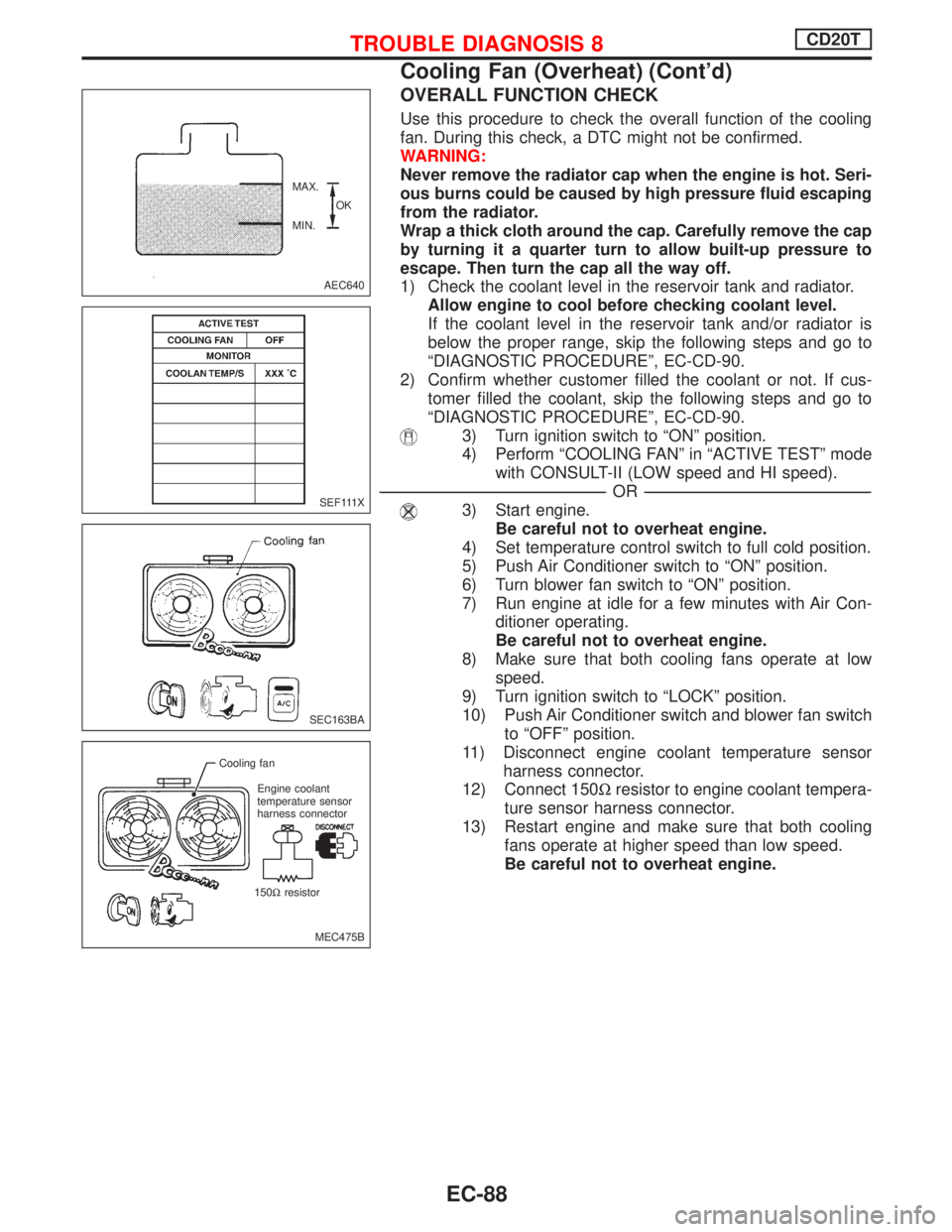
OVERALL FUNCTION CHECK
Use this procedure to check the overall function of the cooling
fan. During this check, a DTC might not be confirmed.
WARNING:
Never remove the radiator cap when the engine is hot. Seri-
ous burns could be caused by high pressure fluid escaping
from the radiator.
Wrap a thick cloth around the cap. Carefully remove the cap
by turning it a quarter turn to allow built-up pressure to
escape. Then turn the cap all the way off.
1) Check the coolant level in the reservoir tank and radiator.
Allow engine to cool before checking coolant level.
If the coolant level in the reservoir tank and/or radiator is
below the proper range, skip the following steps and go to
ªDIAGNOSTIC PROCEDUREº, EC-CD-90.
2) Confirm whether customer filled the coolant or not. If cus-
tomer filled the coolant, skip the following steps and go to
ªDIAGNOSTIC PROCEDUREº, EC-CD-90.
3) Turn ignition switch to ªONº position.
4) Perform ªCOOLING FANº in ªACTIVE TESTº mode
with CONSULT-II (LOW speed and HI speed).
--------------------------------------------------------------------------------------------------------------------------------------------------------------------------------------------------------------------------------------------------------------OR--------------------------------------------------------------------------------------------------------------------------------------------------------------------------------------------------------------------------------------------------------------
3) Start engine.
Be careful not to overheat engine.
4) Set temperature control switch to full cold position.
5) Push Air Conditioner switch to ªONº position.
6) Turn blower fan switch to ªONº position.
7) Run engine at idle for a few minutes with Air Con-
ditioner operating.
Be careful not to overheat engine.
8) Make sure that both cooling fans operate at low
speed.
9) Turn ignition switch to ªLOCKº position.
10) Push Air Conditioner switch and blower fan switch
to ªOFFº position.
11) Disconnect engine coolant temperature sensor
harness connector.
12) Connect 150Wresistor to engine coolant tempera-
ture sensor harness connector.
13) Restart engine and make sure that both cooling
fans operate at higher speed than low speed.
Be careful not to overheat engine.
AEC640 MAX.
MIN.OK
SEF111X
SEC163BA
MEC475B Cooling fan
Engine coolant
temperature sensor
harness connector
150Wresistor
TROUBLE DIAGNOSIS 8CD20T
Cooling Fan (Overheat) (Cont'd)
EC-88